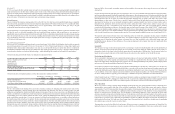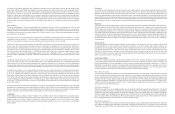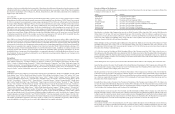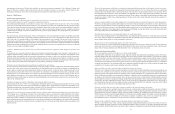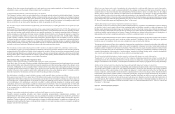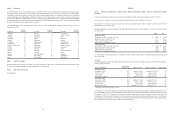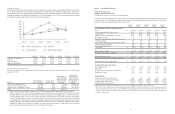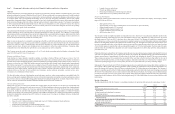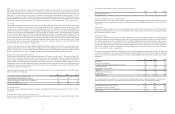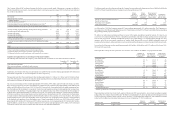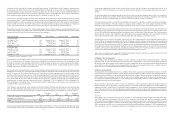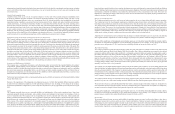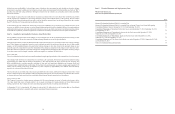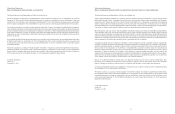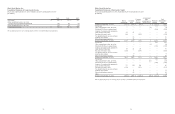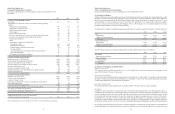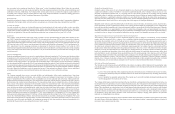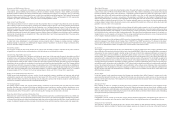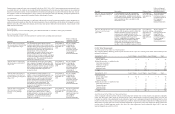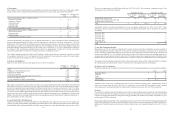Whole Foods 2015 Annual Report Download - page 19
Download and view the complete annual report
Please find page 19 of the 2015 Whole Foods annual report below. You can navigate through the pages in the report by either clicking on the pages listed below, or by using the keyword search tool below to find specific information within the annual report.
25
Subsequent to fiscal year end, the Company repurchased approximately 7.8 million shares of the Company’s common stock at
an average price per share of $30.15 for a total of approximately $234 million. On November 4, 2015, the Board authorized a
new share repurchase program whereby the Company may make up to $1.0 billion in stock purchases of outstanding shares of
common stock of the Company. The new repurchase program does not have an expiration date. The Company’s total authority
under existing repurchase programs was approximately $1.2 billion at November 11, 2015.
Under the share repurchase programs, purchases can be made from time to time using a variety of methods, which may include
open market purchases. The specific timing, price and size of purchases will depend on prevailing stock prices, general economic
and market conditions, and other considerations. Purchases may be made through a Rule 10b5-1 plan pursuant to pre-determined
metrics set forth in such plan. The Board’s authorization of the share repurchase program does not obligate the Company to
acquire any particular amount of common stock, and the program may be suspended or discontinued at any time.
During the first quarter of fiscal year 2015, the Board authorized an increase in the Company’s quarterly dividend to $0.13 per
common share from $0.12 per common share. The following table provides a summary of dividends declared per common share
during fiscal years 2015 and 2014 (in millions, except per share amounts):
Date of declaration Dividend per
common share Date of record Date of payment Total amount
)LVFDO\HDU
November 5, 2014 $ 0.13 January 16, 2015 January 27, 2015 $ 47
March 10, 2015 0.13 April 10, 2015 April 21, 2015 47
June 9, 2015 0.13 July 2, 2015 July 14, 2015 47
September 15, 2015 (1) 0.13 October 2, 2015 October 13, 2015 45
)LVFDO\HDU
November 1, 2013 $ 0.12 January 17, 2014 January 28, 2014 $ 45
February 24, 2014 0.12 April 11, 2014 April 22, 2014 44
June 12, 2014 0.12 July 3, 2014 July 15, 2014 44
September 11, 2014 0.12 September 26, 2014 October 7, 2014 43
(1) Dividend accrued at September 27, 2015
On November 4, 2015, the Board authorized an increase in the Company’s quarterly dividend to $0.135 per common share from
$0.13 per common share. The Company will pay future dividends at the discretion of the Board. The continuation of these
payments, the amount of such dividends, and the form in which dividends are paid (cash or stock) depend on many factors,
including the results of operations and the financial condition of the Company. Subject to these qualifications, the Company
currently expects to pay dividends on a quarterly basis.
Net proceeds to the Company from the exercise of stock options by team members are driven by a number of factors, including
fluctuations in our stock price, and totaled approximately $66 million, $42 million and $81 million in fiscal years 2015, 2014
and 2013, respectively. The Company intends to keep its broad-based stock option program in place, but also intends to limit
the number of shares granted in any one year so that annual earnings dilution from share-based payment expense will not exceed
10%. The Company believes this strategy is best aligned with its stakeholder philosophy because it limits future earnings dilution
from options and at the same time retains the broad-based stock option plan, which the Company believes is important to team
member morale, its unique corporate culture and its success. At September 27, 2015, September 28, 2014 and September 29,
2013 approximately 32.9 million shares, 37.6 million shares and 42.3 million shares of our common stock, respectively, were
available for future stock incentive grants.
The Company is committed under certain capital leases for rental of certain buildings, land and equipment, and certain operating
leases for rental of facilities and equipment. These leases expire or become subject to renewal clauses at various dates through
2054. The following table shows payments due by period on contractual obligations as of September 27, 2015 (in millions):
Total Less than 1
year
1-3
years
3-5
years
More than 5
years
Capital lease obligations (including interest) $ 102 $ 6 $ 12 $ 10 $ 74
Operating lease obligations (1) 8,902 430 1,018 1,066 6,388
Total $ 9,004 $ 436 $ 1,030 $ 1,076 $ 6,462
(1) Amounts exclude taxes, insurance and other related expense
Gross unrecognized tax benefits and related interest and penalties at September 27, 2015 were not material. Although a reasonably
reliable estimate of the period of cash settlement with respective taxing authorities cannot be determined due to the high degree
26
of uncertainty regarding the timing of future cash outflows associated with the Company’s unrecognized tax benefits, as of
September 27, 2015, the Company does not expect tax audit resolution will reduce its unrecognized tax benefits in the next 12
months.
We periodically make other commitments and become subject to other contractual obligations that we believe to be routine in
nature and incidental to the operation of the business. Management believes that such routine commitments and contractual
obligations do not have a material impact on our business, financial condition or results of operations.
Our principal historical sources of liquidity have included cash generated by operations, available cash and cash equivalents,
and short-term investments. Absent any significant change in market conditions, we expect planned expansion and other
anticipated working capital and capital expenditure requirements for the next 12 months will be funded by these sources.
Subsequent to fiscal year 2015, the Company entered into a new credit facility (“the Credit Agreement”) that provides for an
unsecured revolving credit facility in the aggregate principal amount of $500 million, which may be increased from time to time
by up to $250 million in the aggregate pursuant to an expansion feature set forth in the Credit Agreement. The Credit Agreement
also provides for a letter of credit subfacility of up to $250 million and a swingline subfacility of up to $50 million. The Credit
Agreement is scheduled to mature, and the commitments thereunder will terminate, on November 2, 2020.
In addition, prior to the end of the first quarter of fiscal year 2016, the Company intends to incur additional long-term debt of
up to $1.0 billion. The amount and composition of this debt will depend on market conditions and capital allocation considerations
at the time the debt is incurred. The Company may also incur additional short-term debt of up to $350 million, which would be
repaid with proceeds from the long-term debt. The Company intends on continuing to maintain a strong investment-grade profile
and a balance sheet that provides the financial flexibility to pursue its strategic growth initiative. Proceeds from any debt incurred
would be used for general corporate purposes, including the repurchase of stock. The Company’s intent is to spend the majority
of the new $1.0 billion share repurchase authorization in the first half of fiscal year 2016.
There can be no assurance, however, that the Company will continue to generate cash flows at or above current levels or that
other sources of capital will be available to us in the future.
Off-Balance Sheet Arrangements
Our off-balance sheet arrangements at September 27, 2015 consisted of operating leases disclosed in the above contractual
obligations table, as well as the Credit Agreement discussed above. Additionally, we enter into forward purchase agreements
for certain products in the ordinary course of business. Purchase commitments do not exceed anticipated use within an operating
cycle. We have no other off-balance sheet arrangements that have had, or are reasonably likely to have, a material current or
future effect on our consolidated financial statements or financial condition.
Critical Accounting Policies
The preparation of our financial statements in conformity with generally accepted accounting principles requires us to make
estimates and assumptions that affect the reported amounts of assets, liabilities, revenues, expenses and related disclosures of
contingent assets and liabilities. Actual amounts may differ from these estimates. We base our estimates on historical experience
and on various other assumptions and factors that we believe to be reasonable under the circumstances. On an ongoing basis,
we evaluate the continued appropriateness of our accounting policies and resulting estimates to make adjustments we consider
appropriate under the facts and circumstances.
We have chosen accounting policies that we believe are appropriate to report accurately and fairly our operating results and
financial position, and we apply those accounting policies in a consistent manner. Our significant accounting policies are
summarized in Note 2 of the Notes to Consolidated Financial Statements in “Item 8. Financial Statements and Supplementary
Data” of this report. We believe that the following accounting policies are the most critical in the preparation of our financial
statements because they involve the most difficult, subjective or complex judgments about the effect of matters that are inherently
uncertain.
Inventories
The Company values inventories at the lower of cost or market. Cost was determined using the dollar value retail last-in, first-
out (“LIFO”) method for approximately 92.2% and 93.5% of inventories in fiscal years 2015 and 2014, respectively. Under the
LIFO method, the cost assigned to items sold is based on the cost of the most recent items purchased. As a result, the costs of
the first items purchased remain in inventory and are used to value ending inventory. The excess of estimated current costs over
LIFO carrying value, or LIFO reserve, was approximately $49 million and $48 million at September 27, 2015 and September 28,
2014, respectively. Costs for remaining inventories are determined by the first-in, first-out method. Cost before the LIFO


